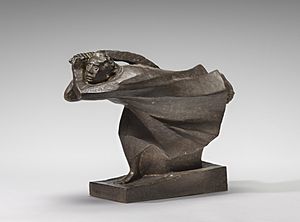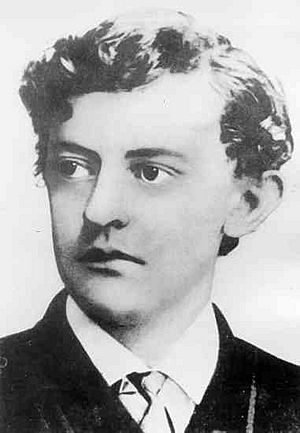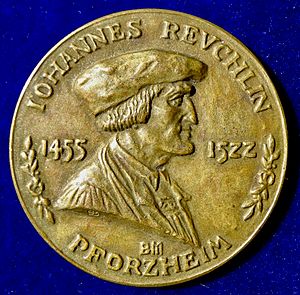Ernst Barlach facts for kids
Quick facts for kids
Ernst Barlach
|
|
|---|---|

Ernst Barlach Self-portrait (1928)
|
|
| Born |
Ernst Heinrich Barlach
2 January 1870 Wedel, Holstein
|
| Died | 24 October 1938 (aged 68) Rostock, Mecklenburg
|
| Nationality | German |
| Known for | Sculpture, printmaking, theater, literature |
| Movement | Realism, Expressionism |
Ernst Heinrich Barlach (born January 2, 1870 – died October 24, 1938) was a German artist. He was a sculptor, a printmaker, and a writer. His art style is known as Expressionism, which focuses on showing strong feelings.
At first, Barlach supported World War I. But after he fought in the war, his views changed completely. He became known for his sculptures that protested against war. This caused problems when the Nazi Party came to power in Germany. Many of his artworks were taken away because the Nazis called them "degenerate art" (art they didn't like). His work combines parts of Realism and Expressionism.
Contents
Ernst Barlach's Life Story
Early Years and Family
Ernst Barlach was born in Wedel, a town in Holstein, Germany. He was the oldest of four sons. His father, Dr. Georg Barlach, was a doctor.
Ernst spent his early childhood in Schönberg. In 1876, his family moved to Ratzeburg, where he went to primary school. When his father passed away in 1884, the family moved back to Schönberg. Ernst then attended secondary school there. His family was Lutheran.
Art School and Training

From 1888 to 1891, Barlach studied at the Gewerbeschule in Hamburg. Because he was very talented, he continued his studies. He went to the Royal Art School in Dresden from 1891 to 1895. During this time, he created his first important sculpture, called Die Krautpflückerin (The Herb Plucker).
He then studied for another year in Paris at the Académie Julian. This was from 1895 to 1897. However, he didn't like that German artists often copied French styles. He returned to Paris for a few months in 1897 for more studies.
Finding His Artistic Path
After finishing his studies, Barlach worked as a sculptor in Hamburg and Altona. He mostly worked in the Art Nouveau style. He also drew pictures for the Art Nouveau magazine Jugend. He even taught at a ceramics school. His first art show was in Berlin in 1904.
However, his art didn't sell very well, which made him feel sad. To cheer up, he traveled to Russia for eight weeks in 1906. This trip greatly influenced his art style. While in Russia, his son Nikolaus was born. Barlach later won custody of his son.
After returning from Russia, Barlach's money situation got much better. An art dealer named Paul Cassirer paid him a regular salary for his sculptures. The experiences in Russia and his new financial security helped him create his own unique style. He started to focus on the faces and hands in his sculptures. He made other parts of the figures very simple.
He also began making wood carvings and bronze sculptures. These figures often wore heavy, flowing clothes, like those in early Gothic art. They showed strong feelings and a desire for spiritual connection. He also worked for a German magazine called Simplicissimus. He started writing plays and books too. His art was shown in many exhibitions. In 1909, he spent ten months in Florence, Italy. In 1910, he settled in Güstrow, where he lived for the rest of his life.
World War I and Its Impact
Before World War I, Barlach was very patriotic. He was excited about the war, thinking it would bring a new age for art. You can see this in his sculpture Der Rächer (The Avenger) from 1914. He volunteered to join the war as a soldier in 1915. After three months, he was discharged because of a heart problem.
He returned from the war as a pacifist, strongly against war. The horrors he saw deeply affected all his later artworks.
Growing Fame and Challenges
After the war, Barlach became more famous. He received many awards. He became a member of important art academies in 1919 and 1925. He also won the Kleist Prize for his play Die Sündflut (The Flood) in 1924. This play used the story of Noah to share his own spiritual ideas.
Art Against War
From 1928 onwards, Barlach created many sculptures that spoke out against war. This peaceful message went against the ideas of the rising Nazi party. He faced a lot of criticism.
For example, the city of Magdeburg asked him to create a memorial for World War I. They expected it to show heroic German soldiers. But Barlach created a sculpture called Magdeburger Ehrenmal (Magdeburg Memorial). It showed three German soldiers in a cemetery. They looked tired and sad, showing the pain and despair of war. Next to them were a grieving war widow, a skeleton in a German army helmet, and a civilian (who looked like Barlach himself) covering his eyes and ears in terror.
This artwork caused a big argument with people who supported the war. Some nationalists and Nazis said the soldiers must be foreign, not true Germans. The sculpture was removed. Luckily, Barlach's friends hid it until after the war. It was then returned to the Magdeburg Cathedral. But the attacks on Barlach continued until he died.
Another sculpture, The Fighter of the Spirit (Der Geistkämpfer), was made for a church in Kiel. It was meant to honor human ideals after World War I. The Nazis were angry about its anti-war message. They removed it in 1937 and cut the angel into pieces, planning to melt it down. But it was saved. After World War II, it was repaired and placed outside a church in Kiel. Copies were made, and one is now in the Minneapolis Institute of Art.
In 1931, Barlach began living with Marga Böhmer.
Art Declared "Degenerate"
In 1936, Barlach's artworks were taken from an exhibition. Most of his remaining works were seized as "degenerate art" by the Nazis. This included his Güstrower Ehrenmal (Güstrow Memorial) and Hamburger Ehrenmal (Hamburg Memorial). Barlach was forbidden from working as a sculptor. His membership in art academies was canceled. This rejection is seen in his last artworks. He passed away from heart failure on October 24, 1938, in Rostock.
Because of Nazi propaganda, Barlach was avoided by people in his town. He was falsely accused of being Jewish and a communist. He died in 1938 and is buried in the cemetery of Ratzeburg.
Besides his sculptures, Barlach also wrote eight Expressionist plays. He wrote two novels and an autobiography called Ein selbsterzähltes Leben (A Self-Told Life) in 1928. He also created many woodcuts and lithographs from about 1910 onwards. These included illustrations for his own plays.
Selected Artworks
- 1894: Die Krautpflückerin (The Herb Plucker)
- 1907: Der Melonenesser (The Melon Eater, bronze)
- 1908: Sitzendes Weib (Sitting Woman), Nürnberg
- 1912: Schlafendes Bauernpaar (Sleeping peasant couple), Rostock
- 1914: Der Rächer (The Avenger, bronze)
- 1917: Der tote Tag (The Dead Day, play)
- 1919: Der arme Vetter (The Poor Cousin, play)
- 1919: Mutter und Kind (Mother and Child, bronze)
- 1920: Die Wandlungen Gottes: Der göttliche Bettler (Transfiguration of God: Third Day)
- 1921: Die echten Sedemunds (The Real Sedemunds, play)
- 1921: Johannes Reuchlin (Bronze medal)
- 1924: Die Sintflut (The Flood, play)
- 1925: Der Tod (The Death) Museum Wiesbaden
- 1926: Das Wiedersehen (Christ and Thomas, in wood), Staatliches Museum Schwerin
- 1926: Der blaue Boll (Squire Blue Boll, play)
- 1927: Der schwebende Engel or Güstrower Ehrenmal (The Floating Angel, bronze), Antoniterkirche Cologne and Güstrow Cathedral
- 1928: Der singende Mann (The Singing Man, bronze), Nürnberg
- 1928 Der Geistkämpfer (The Ghost Fighter; The Fighter of the Spirit), Kiel
- 1929: Magdeburger Ehrenmal (Magdeburg cenotaph), Cathedral of Magdeburg, Magdeburg
- 1930: Bettler auf Krücken (Beggar on Crutches)
- 1931: Hamburger Ehrenmal (Hamburg cenotaph), Hamburg
- 1935: Fries der Lauschenden. (nine wooden figures), Ernst Barlach Haus, Hamburg
- 1936: Der Buchleser (The Book Reader), Schwerin
Art Sales
In 2012, Barlach's wooden sculpture Weinende Frau (Weeping Woman) was sold for $938,500. This set a new record for his artwork at an auction.
Images for kids
See also
 In Spanish: Ernst Barlach para niños
In Spanish: Ernst Barlach para niños






